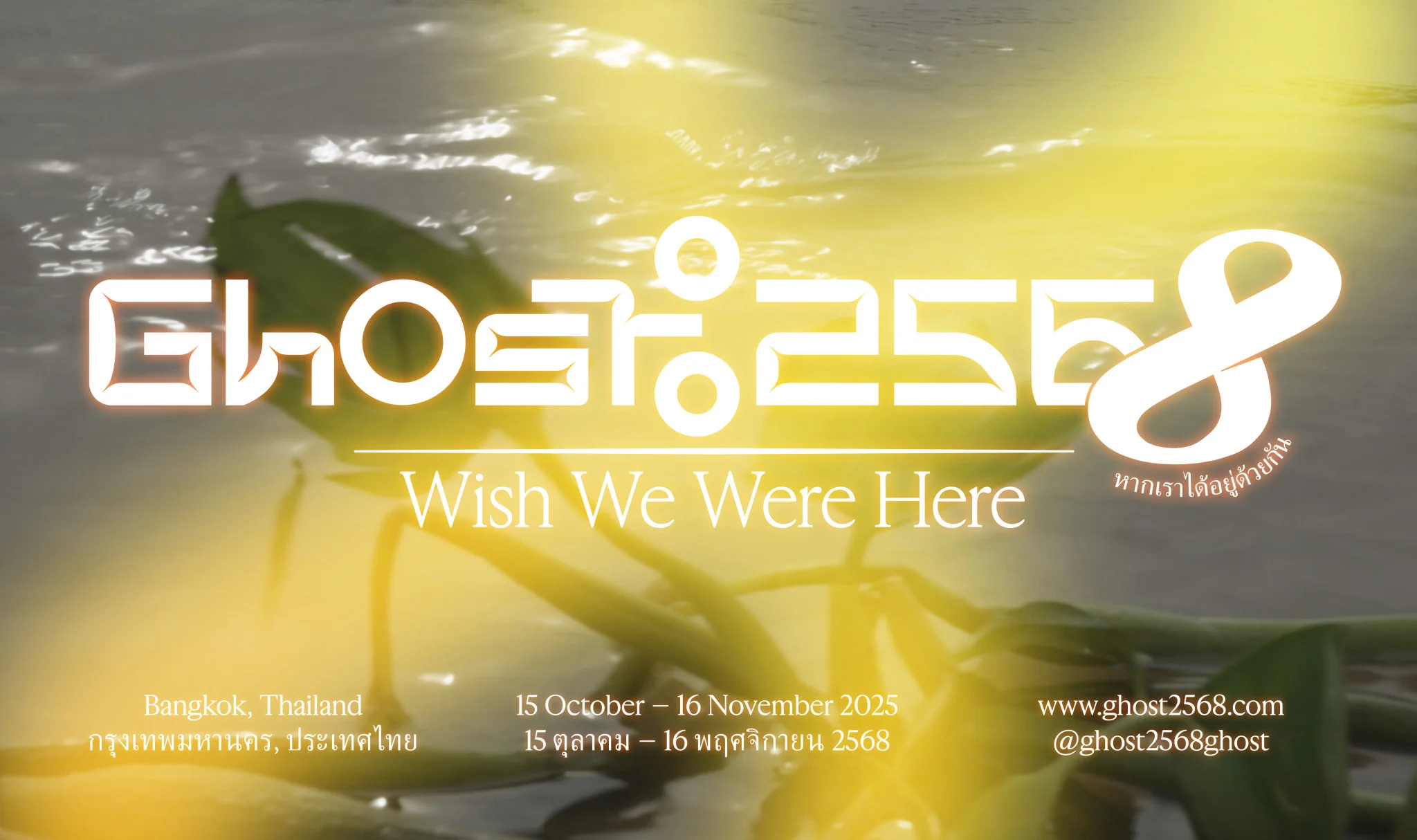
Exhibitions / Gallery 1 & 2, 3rd Floor
EN THGhost 2568: Wish We Were Here
The final edition of Ghost, a video and performance art series taking place in Bangkok, Thailand
Curated by Amal Khalaf
with Christina Li, Korakrit Arunanondchai and Pongsakorn Yananissorn
The third and final edition of Ghost, a video and performance art series—Ghost 2568: Wish We Were Here, curated by Amal Khalaf— takes place from 15 October – 16 November, 2025, across 8 venues in Bangkok. The curators of the first two editions, Christina Li and Korakrit Arunanondchai, return to “haunt” Ghost:2568 with special projects and Host returns, an alternative pedagogical platform by Pongsakorn Yananissorn.
This edition is conceived as a song for survival within the shrinking spaces of freedom in our cities, a meeting place where longings for each other, for lost places, and erased ways of being can take form and find rest. Tracing the edges of Bangkok’s Chao Phraya river, Ghost:2568 explores the unruly and ungovernable ways we bring new worlds into being, and the messy solidarities we craft in the process.
Unfolding as a gathering of moving image, sound, performance, and community Ghost:2568 has an active programme alongside the exhibition. With performances, round tables and workshops with artists, dancers, musicians, fashion collectives and metaphysical practitioners, Ghost:2568 becomes a space for collective unlearning and experimentation.
Ghost is a methodology as much as a festival—a way of surfacing genealogies and trajectories of “ghost thinking”. Ghost 2568: Wish We Were Here offers a collective space to commune in rebellion and joy, to share heartbreak, and to imagine the fragile futures that ghosts demand we remember into being.
for each other, for lost places and ways of being can take shape and find rest, Ghost:2568 traces the edges of Bangkok’s Chao Phraya river and explores our entanglements with each other, the worlds we want to live in and the messy, unruly and ungovernable ways we bring those worlds about.
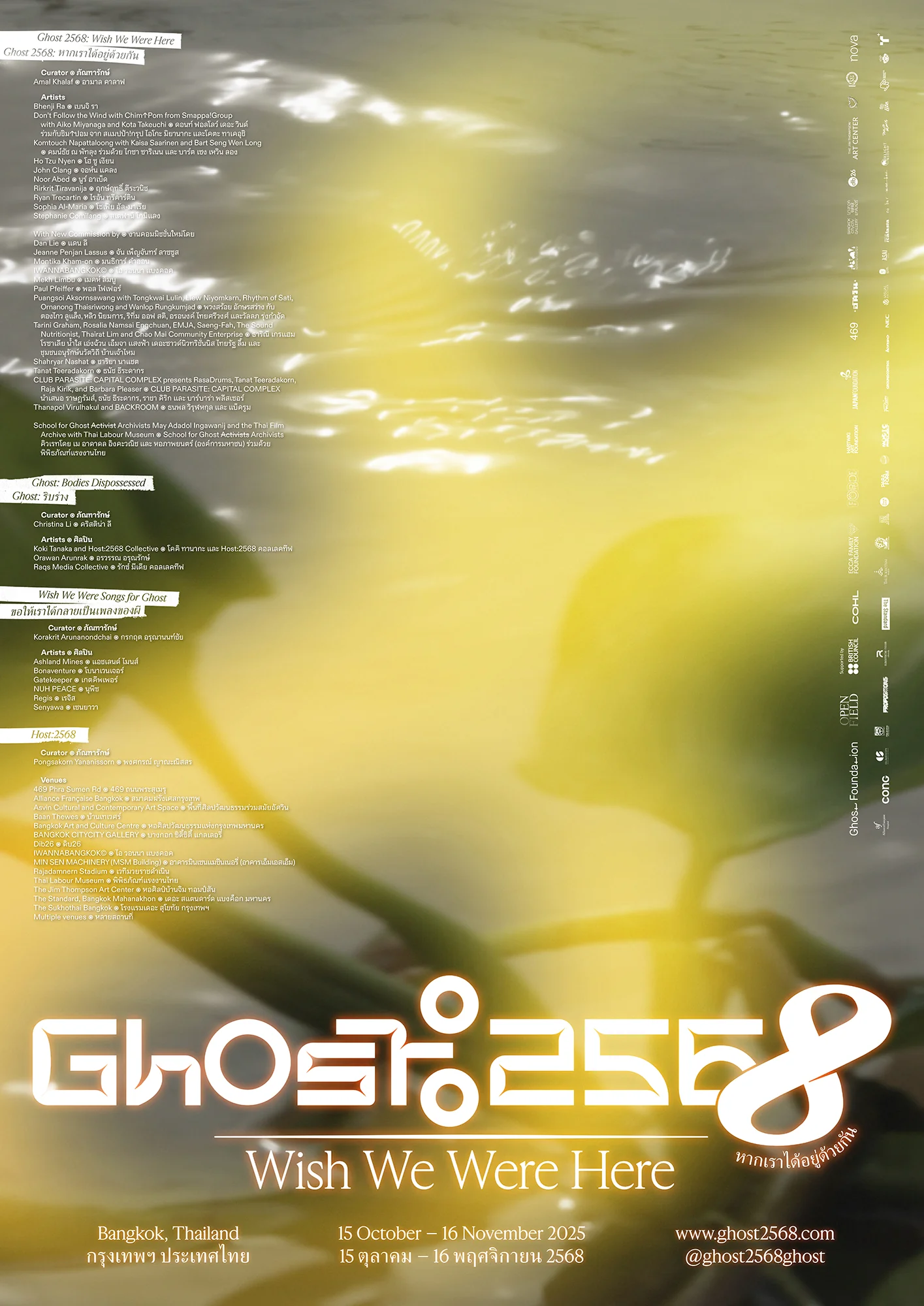
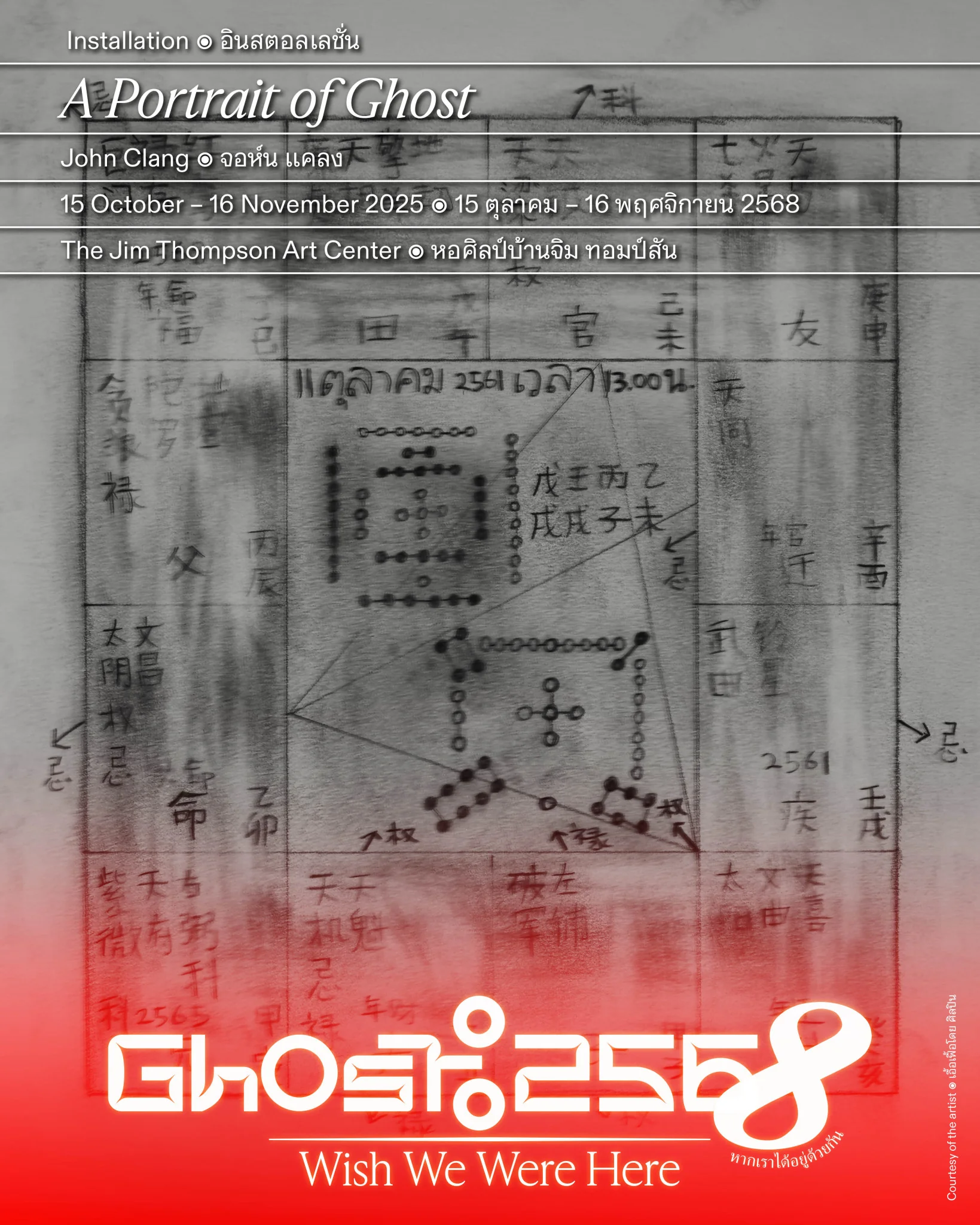
Installation of “Ghost 2568: Wish We Were Here” at the Jim Thompson Art Center — Nine Chairs by John Clang
This installation extends Reading by an Artist into a collective and spatial form. Nine dining chairs, each borrowed from a different family and having witnessed countless domestic moments, are arranged in the pattern of the Later Heaven Bagua (后天八卦) and its Nine Palaces (九宫), guided by the shifting cycles of the San Yuan Xuan Kong Nine Periods system (玄空九运).
Every hour, the chairs are reoriented to align with the most auspicious direction at that moment, channeling the positive energy of the space. Visitors who sit are invited to receive this alignment, to rest in its flow, attune to its rhythm, and open themselves to its potential for renewal and healing.
The central chair remains unseated. It becomes a vessel filled with salt, a material long associated with purification and protection. Each participant is invited to add a handful of salt to this chair before sitting, contributing to the collective act of cleansing and renewal.
These dining chairs carry the traces of family life… conversations, meals, laughter, and arguments, bearing witness to intimate dynamics and personal histories. When positioned within this cosmological framework, they weave together familial memory and the cycles of time and space. The turning of the chairs becomes both a reading of the environment and a ritual of care.
Installation of “Ghost 2568: Wish We Were Here” at the Jim Thompson Art Center — Table of Inquiry by John Clang
This extension of Reading by an Artist transforms the performance table into a space of intimate encounter, collective reflection, and evolving dialogue. The participant sits with the artist at one corner, preserving the one-to-one reading experience that lies at the heart of the practice.
The remainder of the table is covered with a handwritten canvas, weighted by nine stones, on which questions submitted by prior participants are answered by the artist. Visitors are invited to approach the table, locate their questions, and witness their answers in person. Those who chance upon the installation may also submit questions on the spot, which will be recorded and answered in turn, allowing the work to grow and evolve as a living archive of inquiry.
The canvas and stones form a ritualized surface, grounding personal curiosity, attention, and care in tangible form. As questions accumulate, the table becomes both a portrait of collective reflection and a space for individual encounter, where curiosity, presence, and attentive listening converge.
Courtesy of the artist
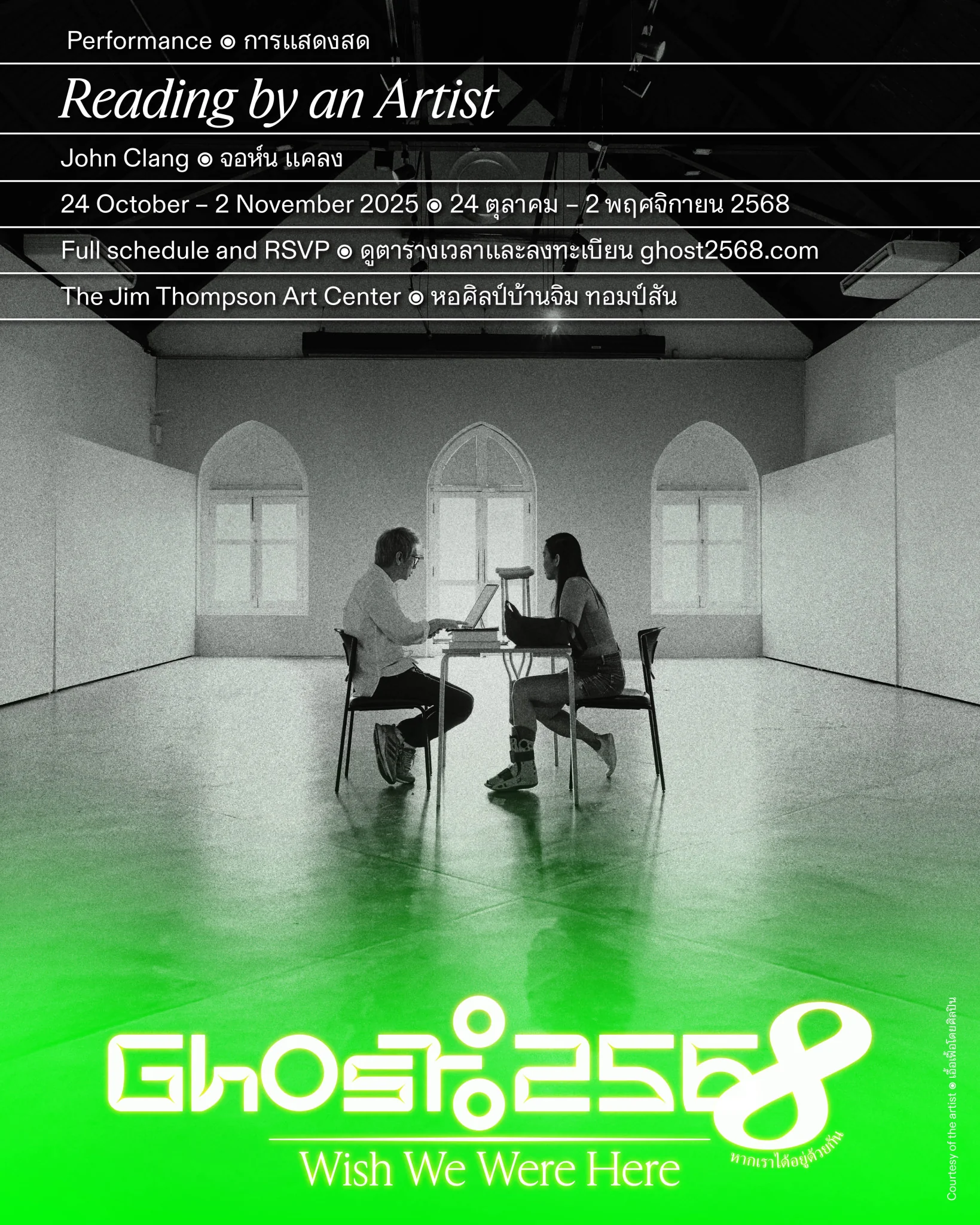
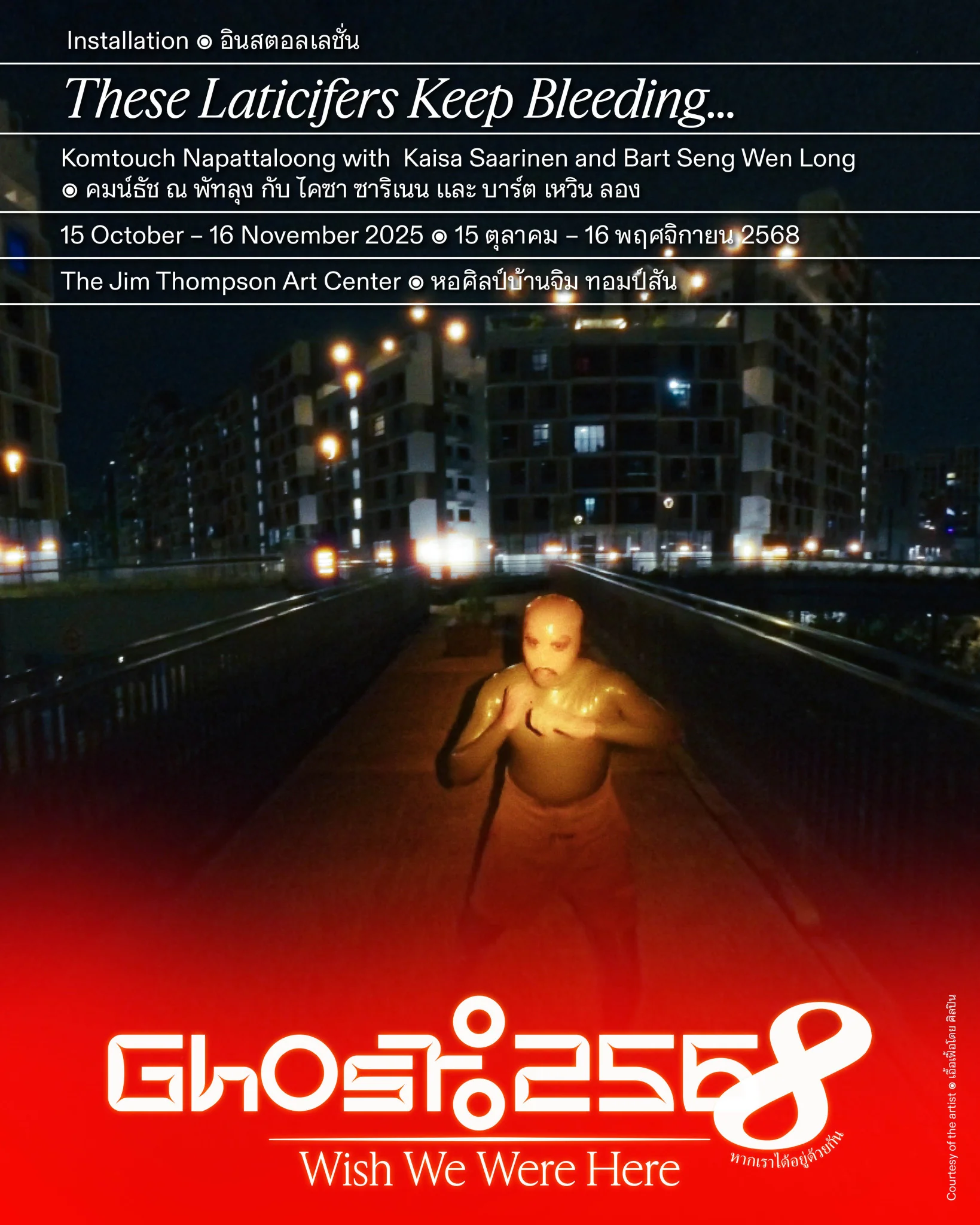
Installation of “Ghost 2568: Wish We Were Here” at the Jim Thompson Art Center — These Laticifers Keep Bleeding…by Komtouch Napattaloong with Kaisa Saarinen and Bart Seng Wen Long
These Laticifers Keep Bleeding… melds together fragments from the larger Rubber Dreams of its Lifetime collaborative project in a three-channel video installation. The material is encountered in its endless guises in Southeast Asia and beyond.
Initiated by Bart Seng Wen Long and Kaisa Saarinen, Rubber Dreams of Its Lifetime explores rubber as commodity fetish and fetish commodity. The project focuses on the Southeast Asian industry as a microcosm of globalised supply chains, connecting with issues and inquiries of global importance. Grounded in extensive field research, it aims to produce a multi-disciplinary body of work, including a documentary-fantasy film titled Heveaphilia. With the intention to subvert mainstream perception of fetishism, the work employs the transformative potential of the fetish to disrupt and expand understanding of the material and its profound influence on social history, pre-modern spirituality, geopolitics and metaphysics.
The project was joined by Bangkok-based artist Komtouch Napattaloong for the field research on rubber production and its entangled histories in Southern Thailand. Spiralling out from this collaboration, In the Land of Lady White Bloodexplores both personal and regional histories of Southern Thailand through essayistic and “post-documentary” cinematic forms. Through the prism of “white blood”—a recurring image tied to latex harvesting, contested land, and regional myths of Lady White Blood—the film traces overlapping legacies of power and violence. These include the fall of the Singora Sultanate, the murky lineage of the Na Phatthalung clan, the development of napalm following the World War II “rubber crisis”, land dispossession and the 1970s anti-communist purges, and the Siamese lords’ expropriation of the Lady White Blood manuscripts.
Extracted from Heveaphilia, four talking-head interviews with rubberists from the SEA region connect their personal relationships with rubber to broader themes of historical materialism, the Malayan Emergency, martial arts physiology, synthetic biology, and the enigmatic nature of the laticifer cell; while fantasmagoric scenes from the film provide a visual backdrop that extends or counterpoints their narrations. These segments collapse with haunted excerpts of Southern Thai myths, revolutionary struggles, familial memories and global warfare from In the Land of Lady White Blood. Through the entangling of these narratives, Laticifers… creates new linkages and resonances that continually expand on each other.
Courtesy of the artists
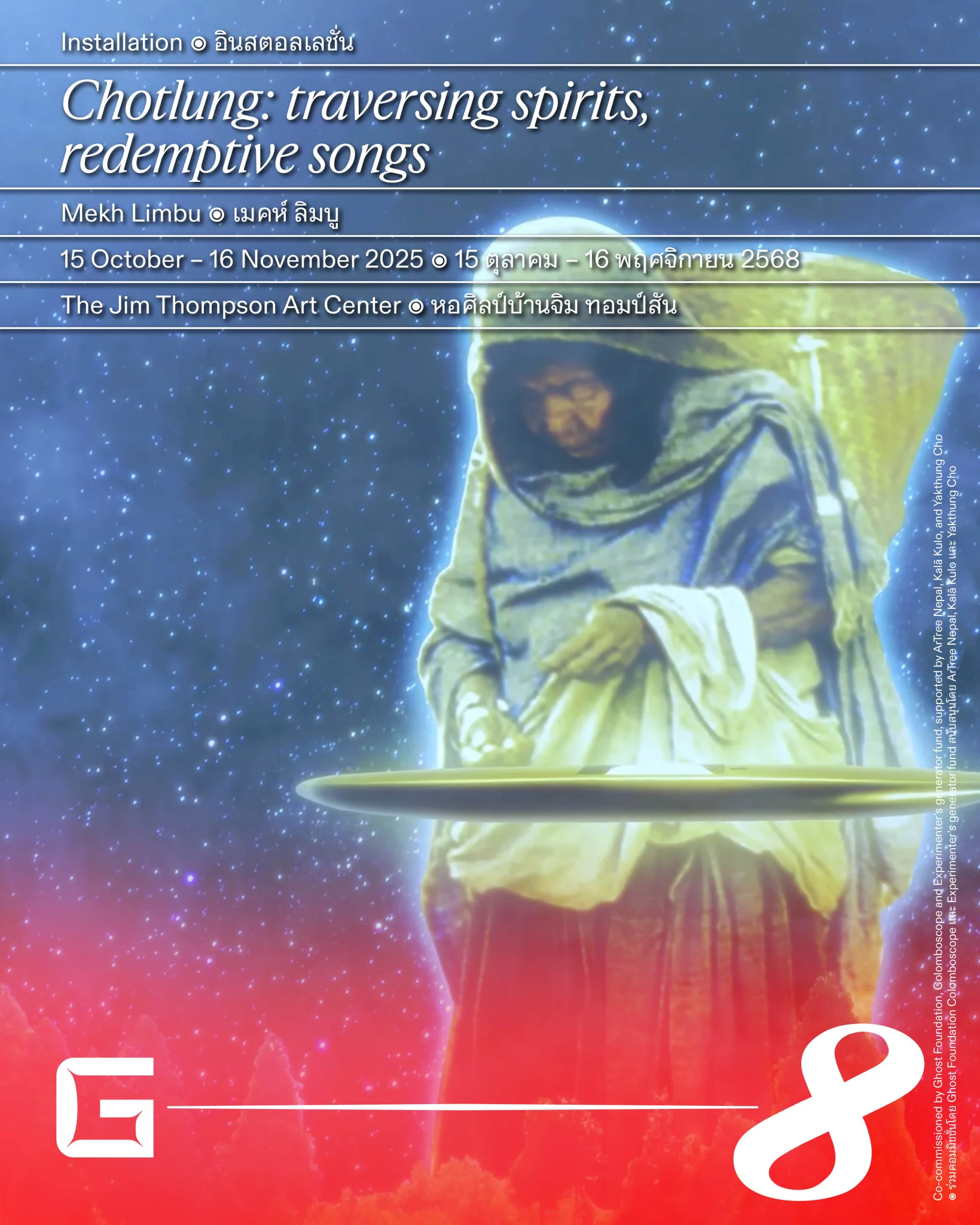
Installation of “Ghost 2568: Wish We Were Here” at the Jim Thompson Art Center — Chotlung: traversing spirits, redemptive songs by Mekh Limbu
I often return to the question: can spaces marked by rupture and detachment become fertile ground for the reclamation of ancestral wisdom? Can we reinvent ourselves not despite, but through these fractures? Much of my work begins with listening—to voices carried through time in oral canons such as the Mundhum, to fragments of family songs, and to the echoes of migration and forced detachment. These are often layered with contemporary sonic textures and visual documents, forming hybrid archives that confront both loss and continuity.
Over the past year, I have been learning the language of weaving, recalling the women in my family—grandmothers, mothers, and aunts—who wove before me. I’ve come to understand how weaving serves as a language that records the history of the Limbu people, while also forming a vocabulary linked to our grandmother goddess Yuma, whose blessing and memory are often ritually invoked through weaving. An initial iteration of this process, a 32 metre-long textile Sam lingma, is currently being exhibited at the 11th Asia Pacific Triennial of Contemporary Art (APT) in Brisbane.
I’m interested in how traditional forms—such as weaving and chanting—can hold space for contemporary demands, and how their meanings shift when mobilized within sites of protest or ecological devastation. Through the Generator Fund, I hope to develop a new body of work that interweaves archival material, moving images, and textiles, grounded in the contested terrain of Mukkumlung—a historically and spiritually significant site for the Limbu community, currently under threat from a state-backed cable car project. This land, deeply tied to ancestral memory and considered as an origin site of Limbu weaving traditions, has recently become a focal point of protest and resistance. The work I envision will draw from oral histories, documentation of recent demonstrations, and my own evolving practice in traditional weaving. In addition to producing my own textiles, I hope to collaborate with community members engaged in the defense and cultural preservation of Mukkumlung. This project will culminate with a presentation of the works at the upcoming Colomboscope exhibition in 2026.
Co-commissioned by Ghost Foundation, Colomboscope and Experimenter’s generator fund, supported by ArTree Nepal, Kalā Kulo, and Yakthung Cho
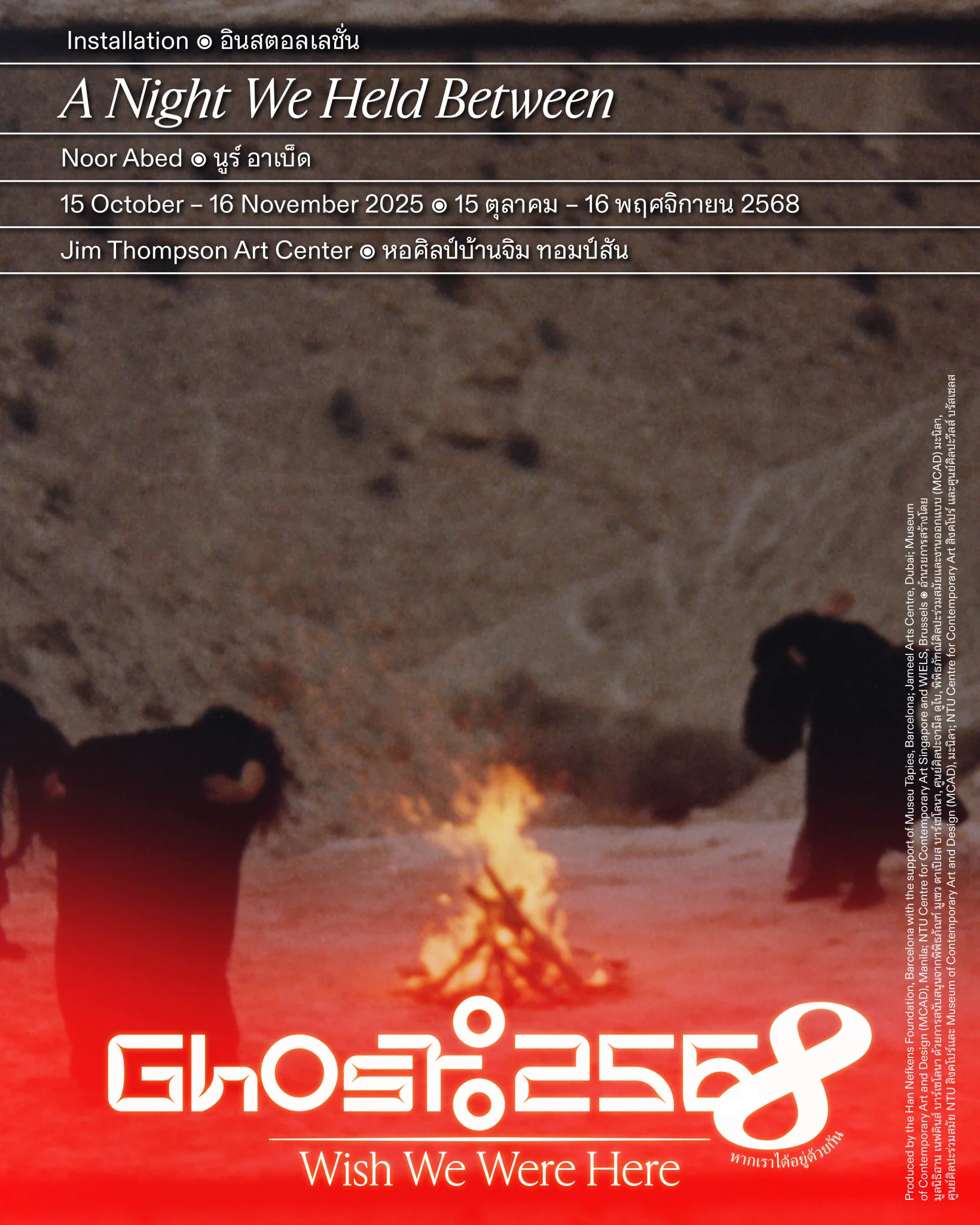
Installation of “Ghost 2568: Wish We Were Here” at the Jim Thompson Art Center — A Night We Held Between by Noor Abed
The film centers around “Song for The Fighters,” which was found at the sonic archive of the Popular Art Center Palestine. Through the layers of the song, in a labyrinth of sounds and sites, the film conjures history as a permanent present tense, a collective and imaginative act.
The film was shot in ancient sites in Palestine—caves, carved holes, underground passages, and wild valleys—the land becomes our main character. It traverses beyond the first layer of visibility to reveal a vast, hidden world similar to the one we know. Throughout the film, scenes intertwine rituals and narratives of community and resistance into everyday representations of social life in Palestine, thus emphasizing the role of collective rhythmic movement and the potential impact that shared feelings can evoke in creating and sustaining a community.
Produced by the Han Nefkens Foundation, Barcelona with the support of Museu Tàpies, Barcelona; Jameel Arts Centre, Dubai; Museum of Contemporary Art and Design (MCAD), Manila; NTU Centre for Contemporary Art Singapore and WIELS, Brussels.
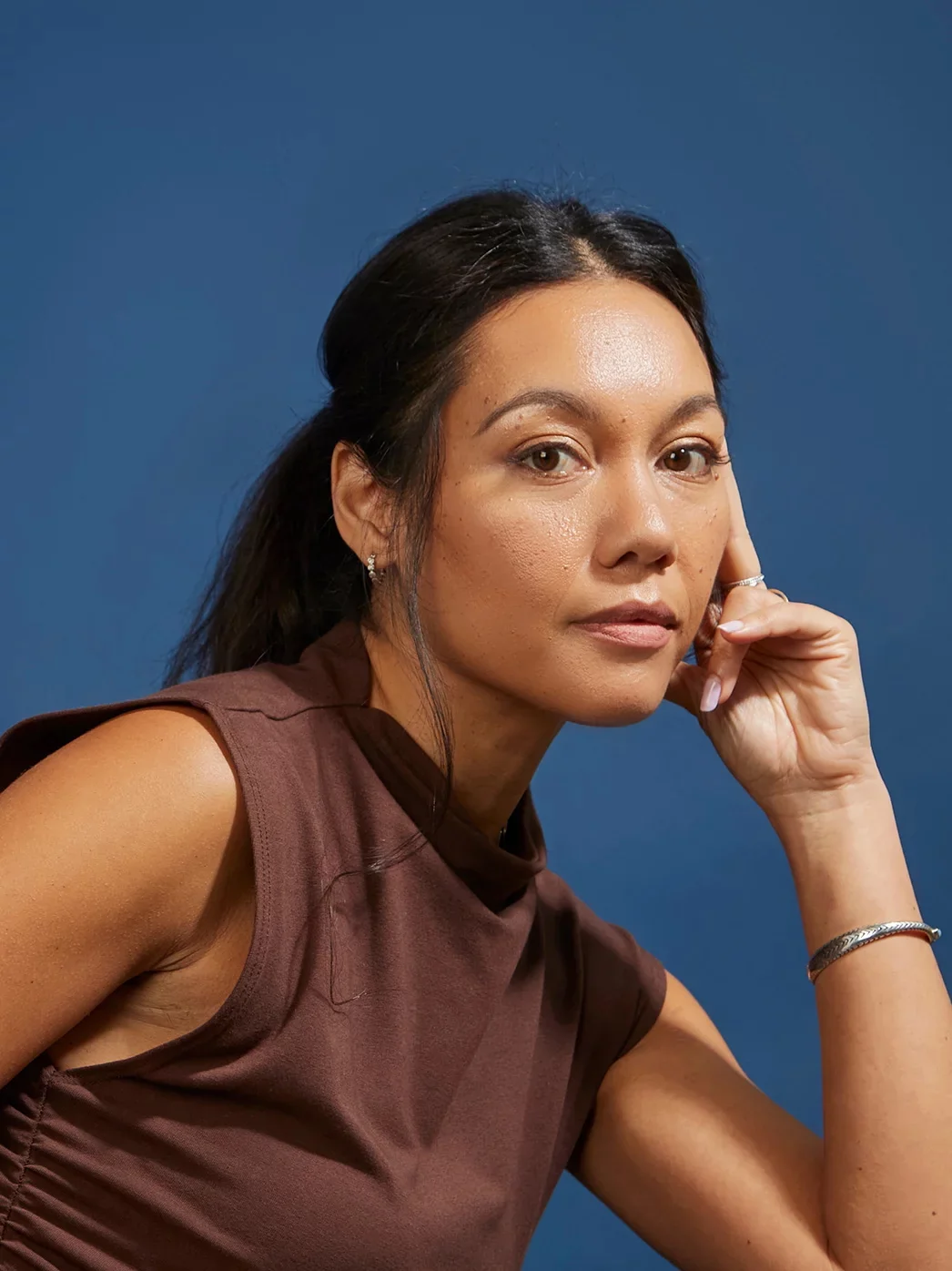
Amal Khalaf
Curator
Amal Khalaf is a curator and artist and is the curator of Ghost:2568 (October – November 2025) in Bangkok, Thailand and co-Artistic Director of Busan Biennale, South Korea (August – November 2026). She is the outgoing Director of Programmes at Cubitt, London (2019–2025) and has recently co-curated Sharjah Biennial 16 (February–June 2025), in the UAE. She served as the Civic Curator at the Serpentine Galleries (2009–2023), where she shaped the Civic programme and commissioned over 50 long term, collaborative projects in neighbourhoods across London. There and in other contexts she has developed residencies, exhibitions and collaborative research projects at the intersection of arts and social justice. Projects include the Edgware Road Project and Centre for Possible Studies (2009-2013), Support Structures for Support Structures (2021), Radio Ballads (2019–2022) and Sensing the Planet (2021). She curated the Bahrain Pavilion for the 58th Venice Biennale (2019) and co-directed the Global Art Forum at Art Dubai (2016). She is a trustee of Mophradat, Athens, and not/nowhere, London, and a founding member of the GCC art collective. She has authored several published essays and recently has co-edited publications including Vertical Atlas (ArtEZ, 2022), How We Hold (Serpentine/Koenig, 2023) and Radio Ballads: Songs for Change (K Verlag, 2025). Her work, exhibitions and research have also been presented at MoMA PS1, New York, the Sharjah Art Foundation, the Whitney Biennial, New York, Serralves, Porto, Musée d’Art Moderne de la Ville de Paris, Grand Palais, Paris, Berlin Biennale, the Fridericianum, Kassel, the New Museum, New York, MUDAM, Luxembourg, Kunsthall Charlottenberg, Denmark, Het Nieuwe Instituut, Rotterdam and the UCCA Centre for Contemporary Art, Beijing amongst others.
Photo Credit: Christa Holka
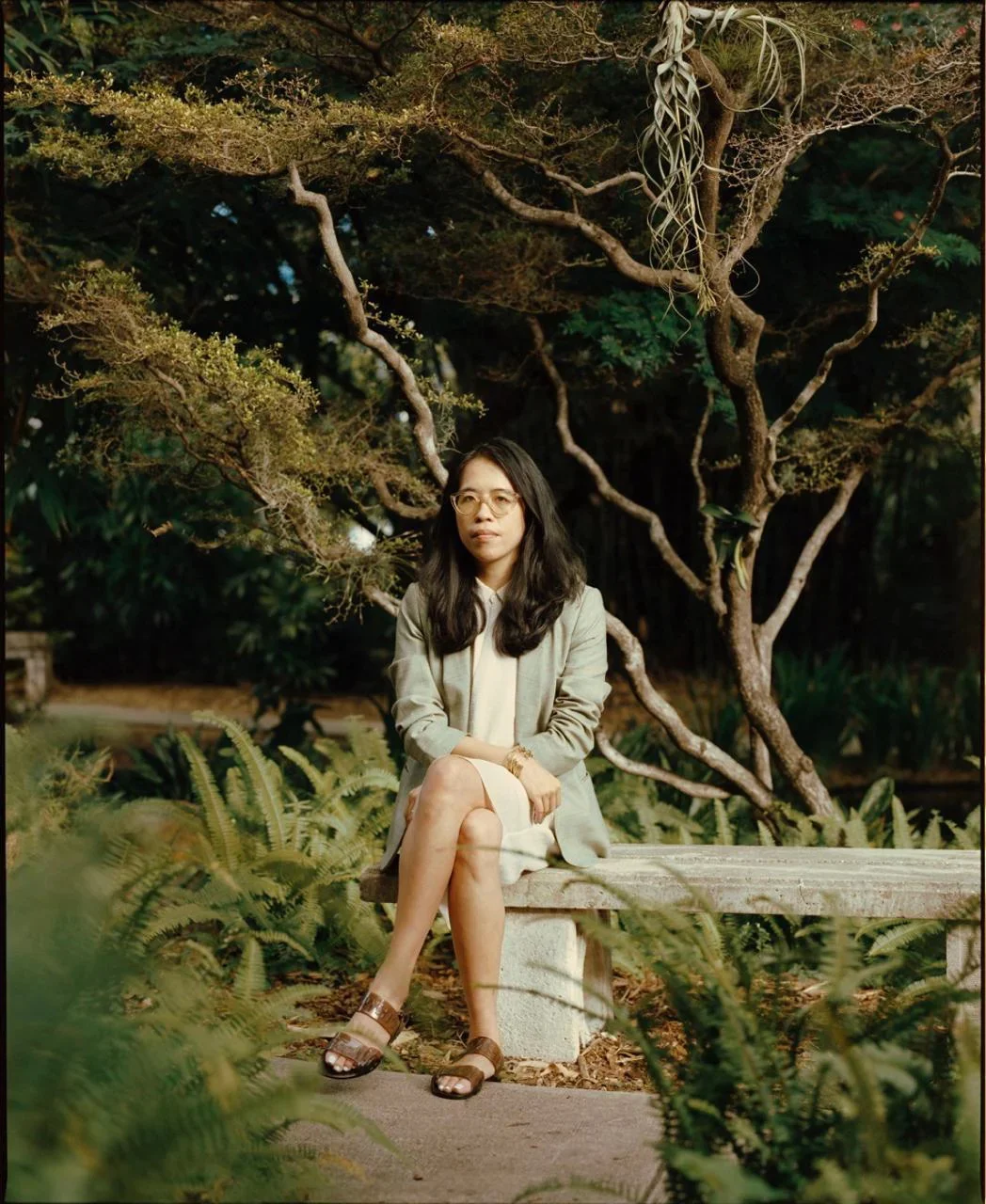
Christina Li
Curator
Christina Li is a Hong Kong-born curator and writer based in Amsterdam, whose artist-driven projects explore the negotiation of diverse identities, perspectives, and experiences across time and cultures. She is co-curator for the forthcoming Sonsbeek 2026 and artistic director of Kim Association, Singapore. She previously directed Spring Workshop, Hong Kong , with key curatorial positions at Para Site (Hong Kong), SKOR (Amsterdam), and BAK, basis voor actuele kunst (Utrecht). Her notable curatorial projects includes the second edition of Ghost 2565: Live Without Dead Time (2022), a triennial video and performance art series in Bangkok; Pilvi Takala’s presentation for the Pavilion of Finland at the 59th Venice Biennale (2022) and Hong Kong’s presentation of Shirley Tse’s work at the 58th Venice Biennale (2019). Her work spans Europe and Asia, with exhibitions at Lafayette Anticipations, Paris; EMMA, Helsinki; M+, Hong Kong; Tai Kwun Contemporary, Hong Kong; Z33, Hasselt among others. Her writings have appeared in exhibition catalogues and publications including ArtReview Asia, LEAP, Parkett, Spike, and Yishu Journal of Contemporary Art.
Photo credit: Art Basel
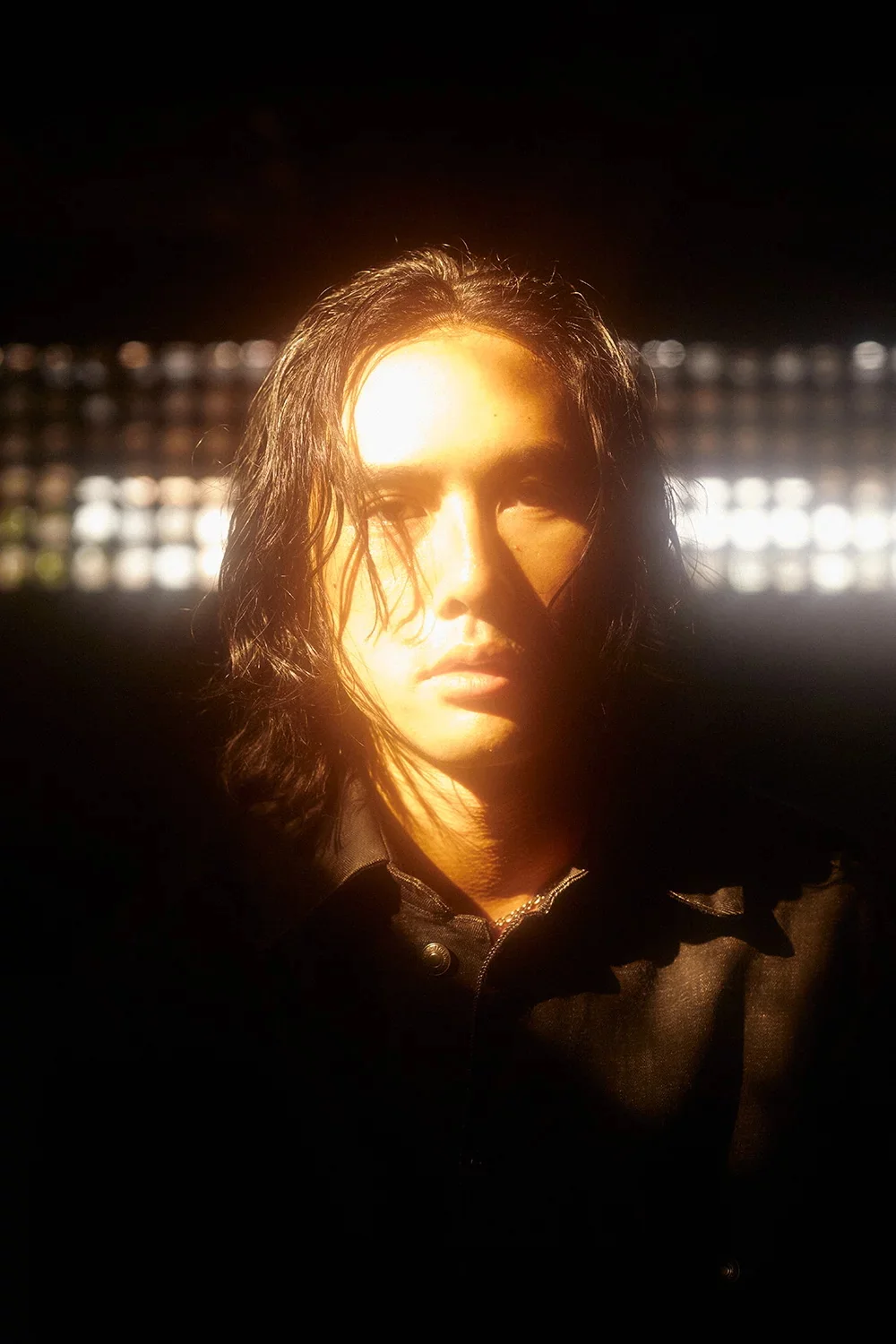
Korakrit Arunanondchai
Curator
A visual artist, filmmaker, and storyteller, Korakrit Arunanondchai employs his versatile practice to tell stories embedded in cultural transplantation and hybridity. His body of work merges fiction with poetry and offers synesthetic experiences engaged in a multitude of subjects primarily based on lives of family, friends, and colleagues as much as local myths. Surpassing a solitary artist, Arunanondchai is an avid collaborator who has worked on videos, performances and music together with an extensive list of people.
Photo Credit: Harit Srikhao
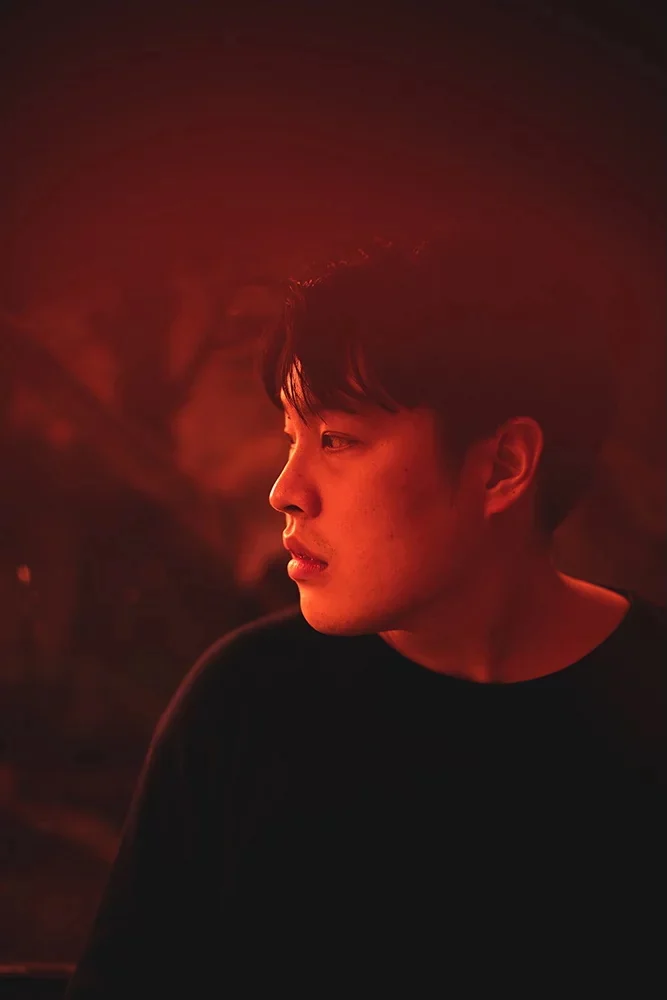
Pongsakorn Yananissorn
Curator
Pongsakorn Yananissorn is an artist and independent curator working around instigating and creating different modes of living and working together through employing shared fictions, stringing forgotten pasts to unrealized futures. He curated projects such as Ramavania, 5th floor, Tokyo (2024), Crypto for Cryptids, JWD Artspace, Bangkok (2021) and Talk-Talk Vilion Pavilion, Bangkok Biennial, Bangkok, (2021) and PostScripts, Bangkok Biennial, Bangkok (2018) among others, as well as curatorial assistant and HOST curator for Ghost 2565 (2022), Bangkok. He co-founded Plaza Projects, Vancouver (2016) as well as starting a new phase of Speedy Grandma Gallery, Bangkok (2020). Currently, he is a member of collectives, Charoen Contemporaries, Bangkok (2018) as well as This Useful Time Machine (2020). He is currently based in Bangkok, Thailand.
Photo Credit: Harit Srikhao
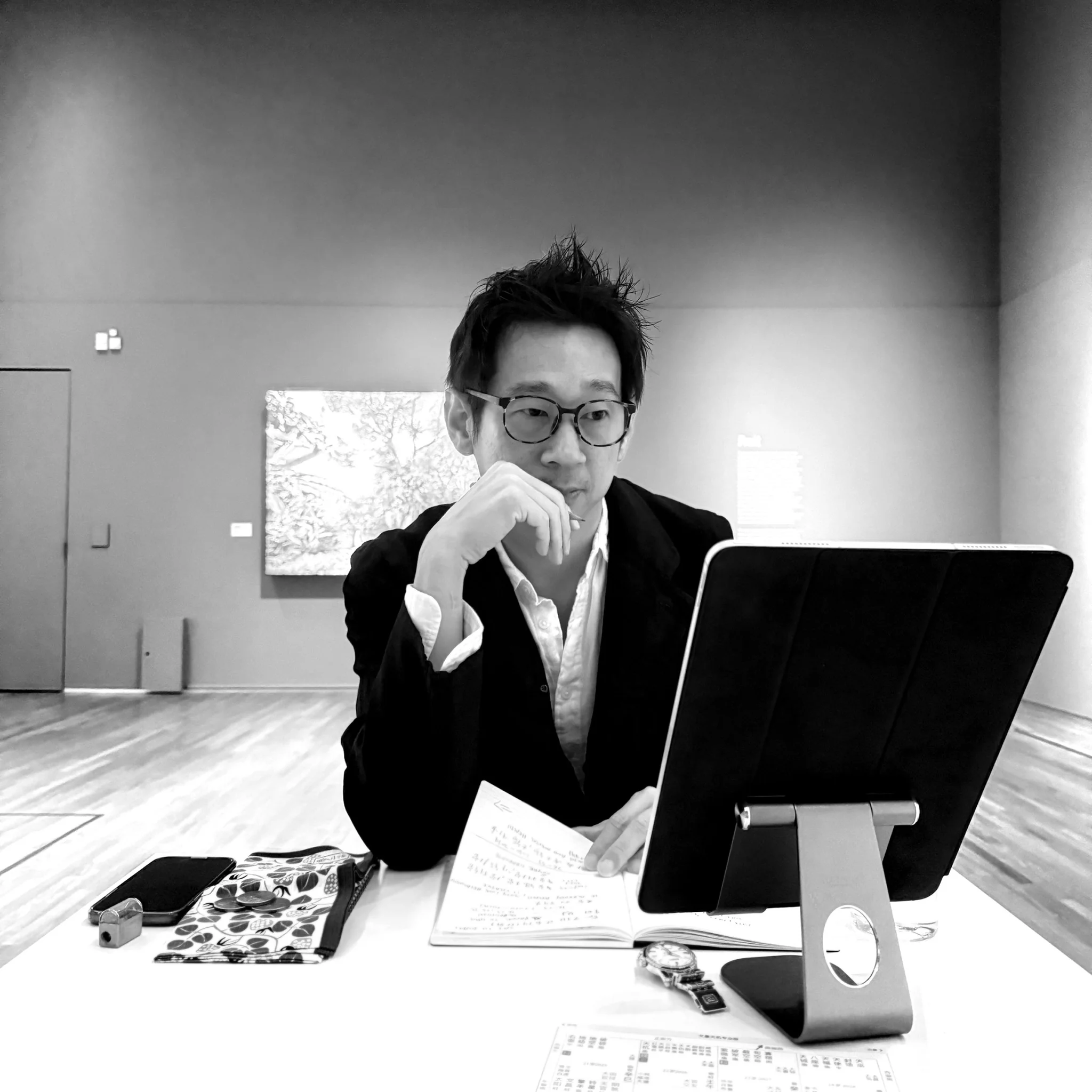
John Clang
Artist
John Clang (b. 1973, Singapore) is a visual artist whose work spans photography, film and metaphysical performance. His practice straddles dual realities within global cities, unfettered by the confines of time and geography.
He draws from mundane external stimuli to reflect on time, memory and displacement. Clang’s performative portraiture work Reading by an Artist was recently presented at Sharjah Biennial 16 and the National Gallery Singapore (both 2025). In 2010, he became the first photographer to receive Singapore’s President’s Design Award (Designer of the Year).
His work has been exhibited and screened at international venues such as ArtScience Museum, Singapore; CCC Strozzina, Florence; Deichtorhallen, Hamburg; International Film Festival Rotterdam; Pera Museum, Istanbul; Singapore Art Museum; and Singapore International Film Festival.
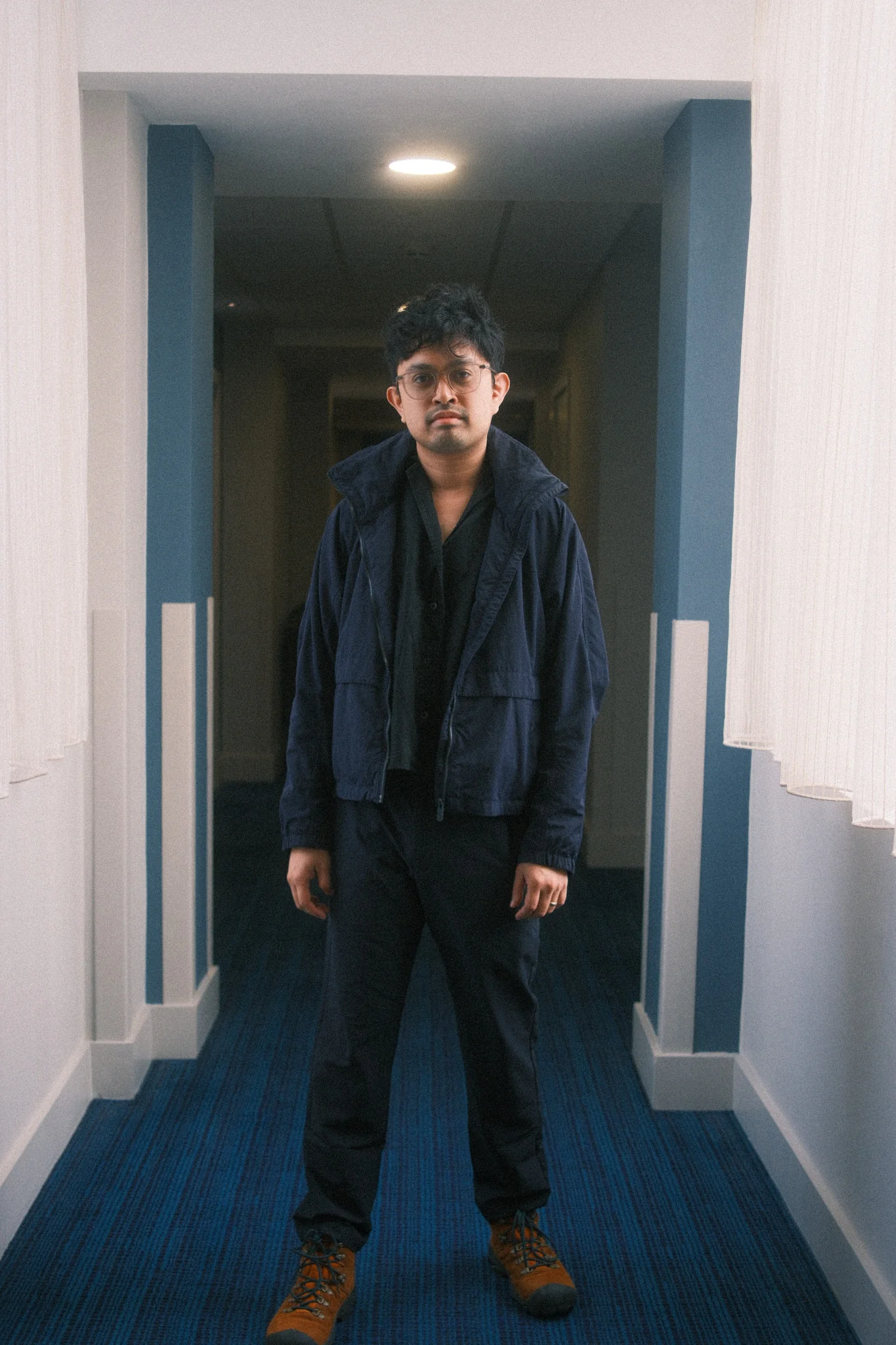
Komtouch Napattaloong
Artist
Exploring identity deconstructions, belonging anxieties, migration narratives, and historical translations, artist filmmaker Komtouch Dew Napattaloong’s latest video piece, ‘NO EXORCISM FILM,’ competed at CPH:DOX 2024 for the NEW:VISION award. His debut feature documentary, ‘HOURS OF OURS,’ premiered at the Visions du Réel 2023 International Competition. A 2016 Abbas Kiarostami Filmmaking in Cuba Workshop participant and a 2024 Berlinale Talents participant, his works have been showcased at international festivals such as JeonjuIFF, 68th BFI London Experimenta, Visions du Réel, SingaporeIFF, Festival Film Dokumenter Jogja, Mar Del Plata, and Thai Video and Short Film Festival. Additionally, his works have been featured at the Bangkok Biennial, Protocinema’s A Few In Many Places Bangkok exhibition, and Thailand Biennale’s Open World Cinema.
Photo credit: Thanakrit Duangmaneeporn
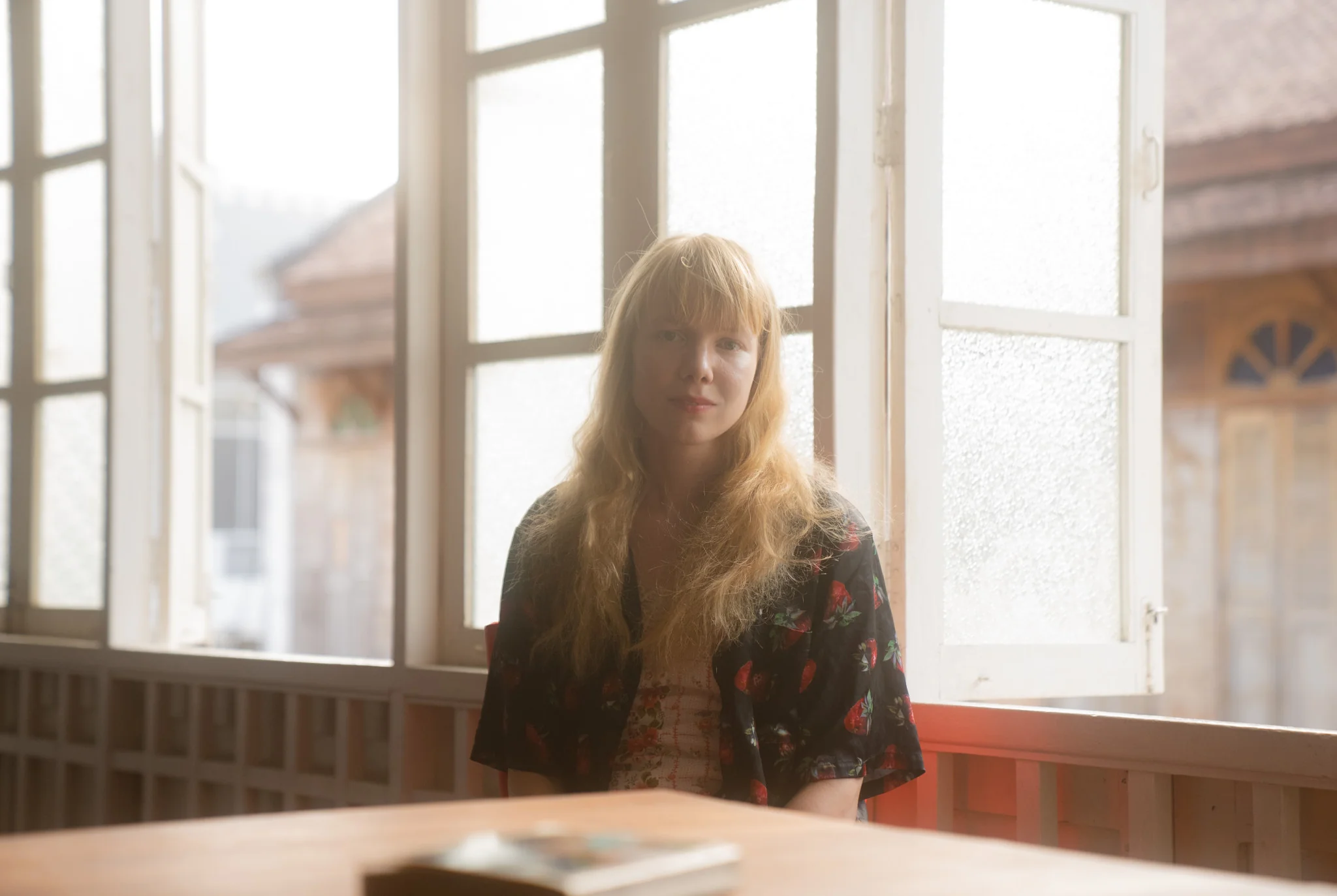
Kaisa Saarinen
Artist
Kaisa Saarinen is a Finnish researcher, poet and writer based in London. She splits her time working in climate policy research, with a focus on forestry and biodiversity, and as an author, with one published novel (‘Weather Underwater’, 2023) and two collections of poetry and short fiction (Voideuse, 2022 & Maitonaut, 2024). In addition, she is translating the poetry of artist-filmmaker Terayama Shuuji — this work has been featured in MUBI Notebook (2024) and The Poetry Review (2024). As part of this project, she curated a hybrid film-performance program commemorating the 50th anniversary of ‘Pastoral: To Die in the Country’ at the ICA London in 2024.
Photo Credit: Komtouch Dew Napattaloong
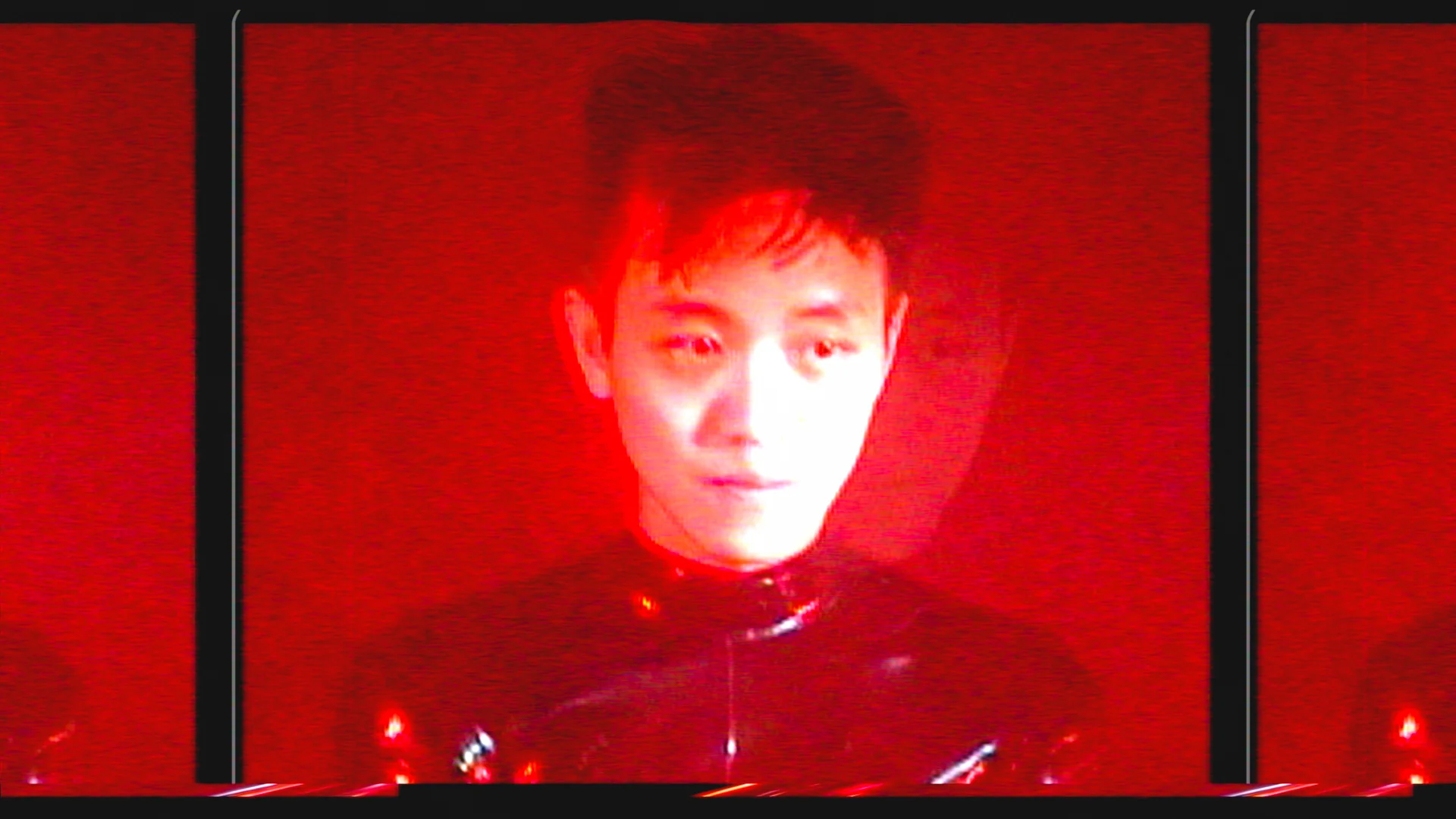
Bart Seng Wen Long
Artist
Bart Seng Wen Long is a Singaporean artist based in London. His practice revolves around the political economy of desire, encounters of otherness, and the transformative potential of fetishism.
Bart is currently a Kone Foundation grantee, and was a Tour de Moon film grant awardee and a finalist for the Circa x Dazed award. His works have been exhibited at Somerset House, London (2024), Kunsthal, Rotterdam (2025), Queer East, London (2023 - 2025), daadgalerie, Berlin (2024), London Short Film Festival (2023), Bishopsgate Institute, London (2023), Barbican Centre, London (2022), CIRCA x DAZED’s Class Of 2021, Screens in London, Seoul & Tokyo (2021), amongst others.
Photo Credit: Jonny Kaye
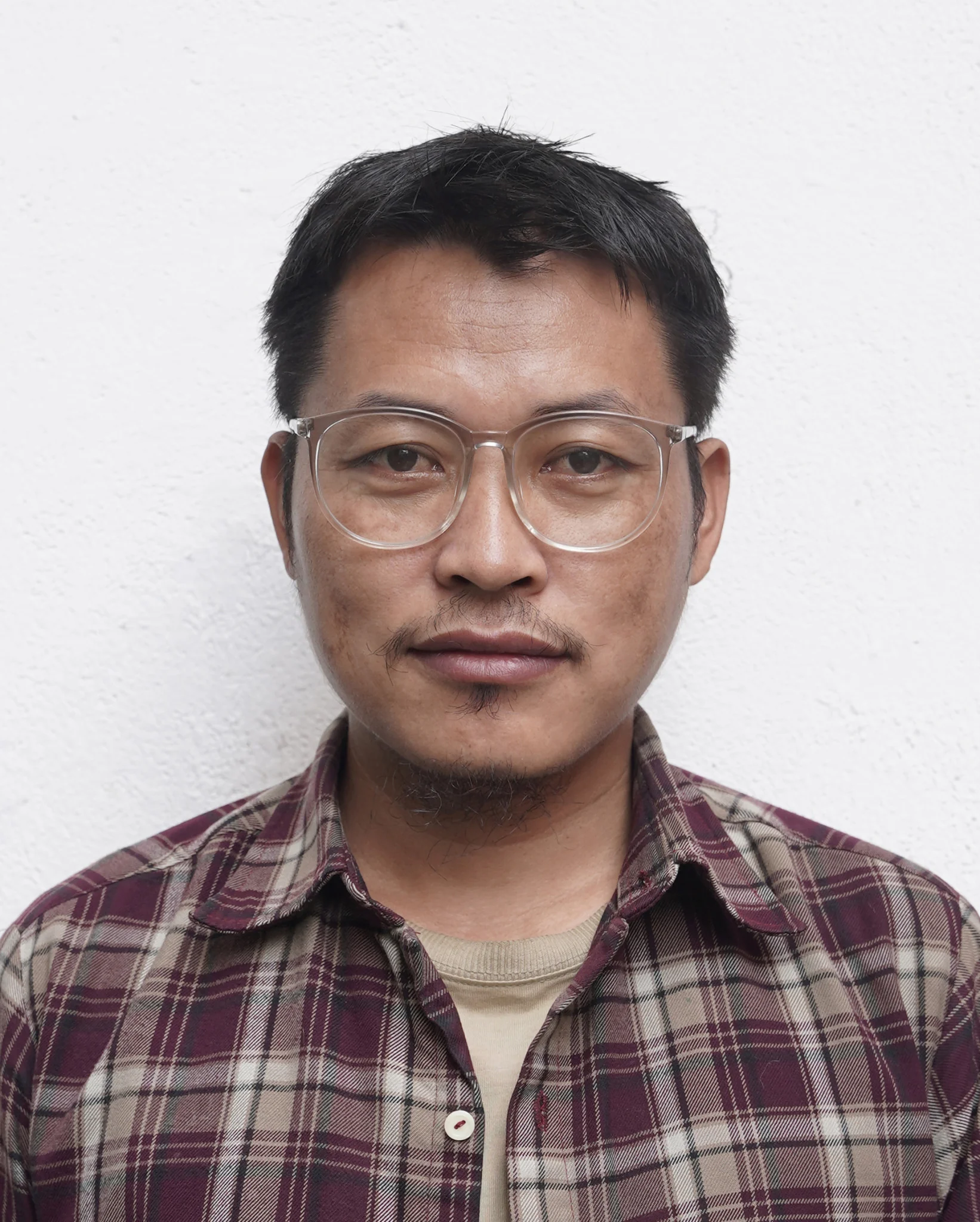
Mekh Limbu
Artist
Mekh Limbu is an artist based in Kathmandu by way of Dhankuta. Belonging to the Adivasi-Janajati Limbu community, his work addresses the geopolitical fractures that stretch and shape Indigeneity. His use of archival matter is grounded in a need for the intergenerational transfer of language, ritual, and memory. Recently, he has also been incorporating vocabularies of weaving to evoke Indigenous modes of knowledge and reclamation. His works also document the ramifications of Nepal’s labour migration industry on his family, underscoring the estrangement of traditional kinship structures. He is a co-founding member of the artist collectives Artree Nepal and Yakthung Cho.
Photo Credit: Kireet Rajbhandari
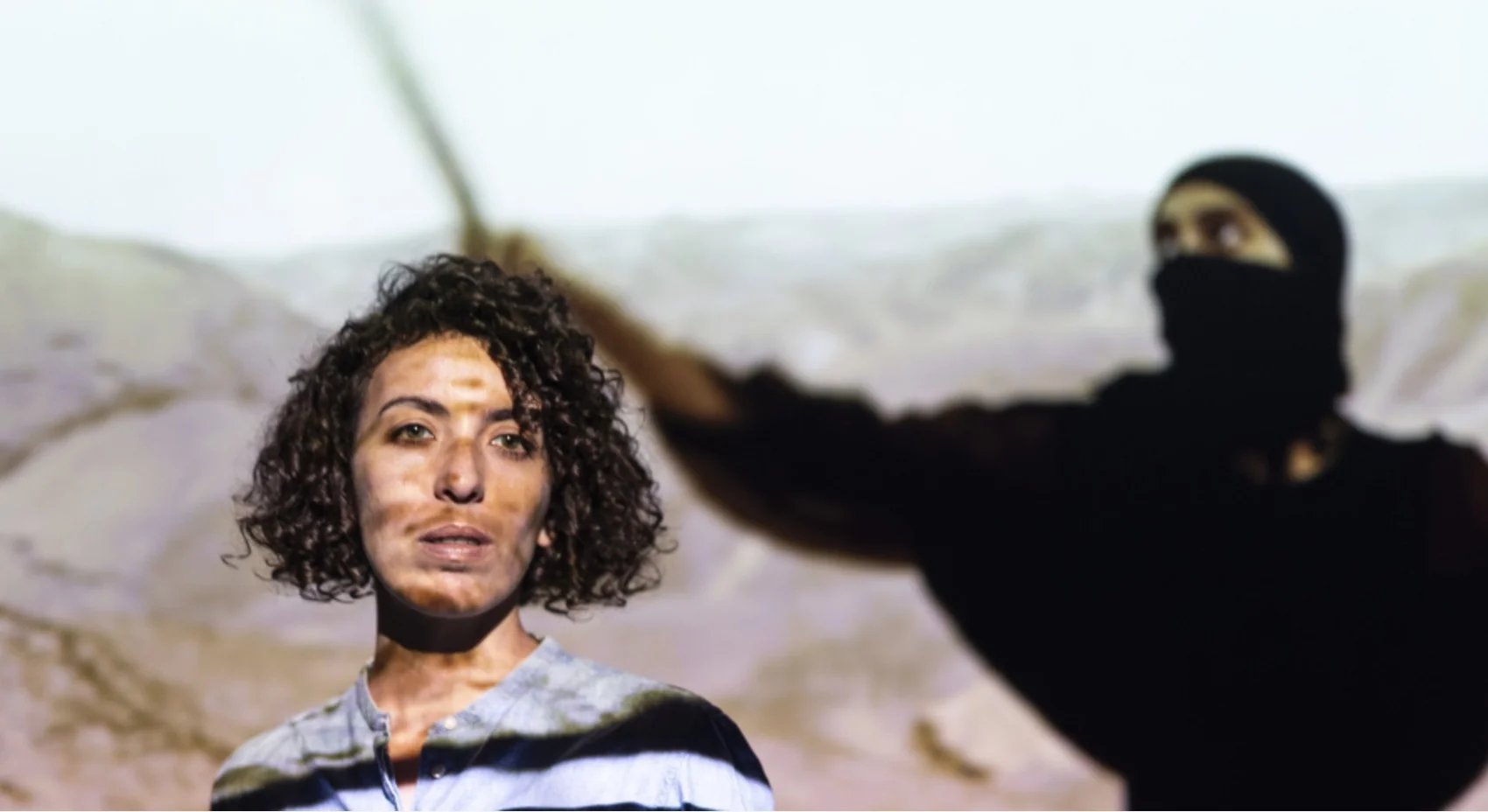
Noor Abed
Artist
Noor Abed (Palestine) is an artist who works at the intersection of performance and film, combining forms of the ‘staged’ and the ‘documentary’. Her practice examines notions of social choreographies and collective formations, searching through the connection between the notion of ‘synchrony’ and social action.
Abed attended the Whitney Independent Study Program in Νew York in 2015-16, and the Home Workspace Program (HWP) at Ashkal Alwan, Beirut 2016-17. In 2020, she co-founded, with Lara Khaldi, the School of Intrusions, an independent educational collective in Ramallah, Palestine. Abed was an assistant curator in documenta fifteen, Kassel 2021-22, an artist in residence at the Rijksakademie in Amsterdam 2022-24. She was awarded the Han Nefkens Foundation/ Museu Tàpies Film Production Grant in 2022, and her film ‘A Night We Held Between’ was selected as a first-prize winner of the e-flux Film Award 2024. Abed is the Grand prize recipient of the 36th Ljubljana Biennale of Graphic Arts, Her book ‘Stars at Midday’ was published by Occasional Papers in October 2024.
Photo credit: Miquel Munoz